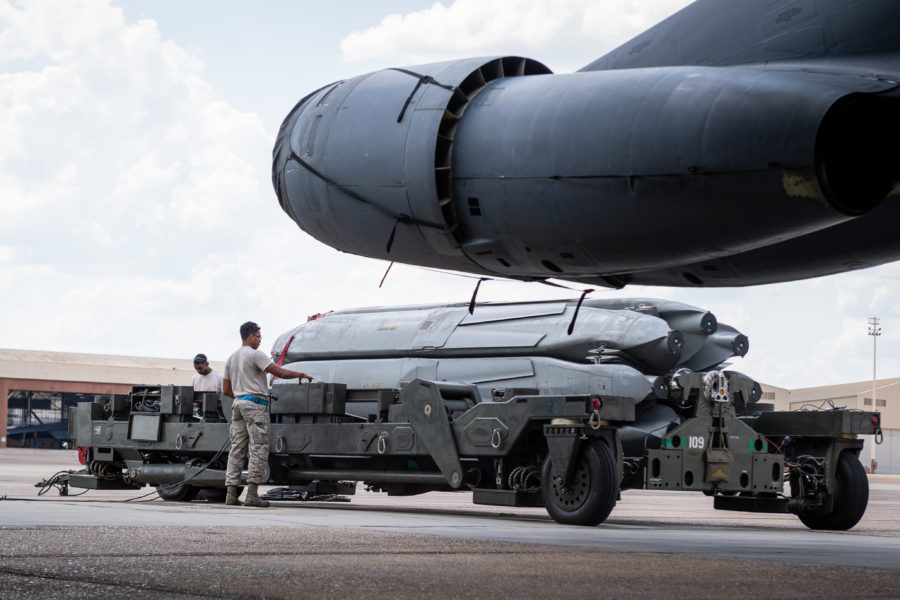The Raytheon AGM-181 Long-Range Standoff missile is on track for a production decision in 2027, having passed its critical design review in March, according to Air Force budget documents.
Justifications for the fiscal year 2024 budget request show that LRSO’s low-rate initial production waypoint—referred to as Milestone C—is set for the third quarter of 2027, when there’s a major shift in planned spending from research, development, test, and evaluation to procurement.
The LRSO’s critical design review—which set the near-final design of the stealthy nuclear missile—narrowly met the program’s projected timeline finishing up in the final few days of February and the early days of March this year. Senior Air Force officials, speaking at the midpoint of the CDR process, predicted no significant issues after its conclusion.
Gen. Duke Richardson, head of Air Force Materiel Command, has said he expects “big bang” design reviews will give way to “rolling” events, made possible by digital design and development, wherein all stakeholders can see the design as it is at any given time.
The LRSO, being developed in secrecy, will succeed the 1980s-vintage AGM-86B Air-Launched Cruise Missile (ALCM), which is being phased out after undergoing several life extension programs. It has even outlasted its previous planned complement/successor, the stealthy AGM-129, which was retired as a cost-saving move in 2012.
President Joe Biden’s administration confirmed the need for LRSO in its Nuclear Posture Review last year, despite previous speculation that it might cancel the program.
Indeed, procurement funding for LRSO ramps steadily upward over the next five years, with a particularly huge increase in fiscal 2027. Air Force budget documents show planned requests of $67 million in 2024, $135.2 million in 2025, and $295.1 million in 2026, before funding balloons to $1.01 billion in 2027. Fiscal 2028 procurement is projected to be $1.7 billion, with another $6.5 billion expected after that through the life of the program.
Conversely, RDT&E funding profile for LRSO peaked in fiscal 2023 at $928.9 million and is slated for a steady decline over the next four years, with $911.4 million in 2024, $704.9 million in 2025, and $600.5 million in 2026. Research funding then plummets to $287.8 million in 2027, with just $76.4 million planned in 2028 and no more monies planned after that.
Gen. Anthony Cotton, head of U.S. Strategic Command, told the Senate Armed Services Committee in March that he was “quite pleased” with the Air Force’s progress on LRSO. At the same time, Cotton also said the ALCM, carried exclusively by the B-52H, is “still a reliable, safe, and secure weapon,” but warned that it is past its projected service life and must be replaced.
The Air Force is planning on an average of about $32 million per year in ALCM procurement funding through 2028, with less than two years funded after that, suggesting an initial operational capability date for LRSO of about 2029-2030.
Raytheon won the contract to build LRSO in July 2021, beating out Lockheed Martin.
The LRSO will initially equip the B-52J but will also be integrated on the stealthy new B-21 Raider bomber. The ALCM was never fitted to the B-2.
Little has been revealed about the LRSO, such as its range and speed, but the Air Force has said it plans to build 1,087 of the missiles, of which some 67 would be used in the development phase. Initially expected to cost about $10 million each, the most recent estimate is that LRSO will cost $13 million each. The Air Force has also said the missile will not be hypersonic.
In its budget justifications, the Air Force said fiscal year 2024 activities for LRSO will include verifying and maturing the design and planning for “manufacturing maturation.” Former AFMC commander Gen. Arnold Bunch reported that the technology maturation and risk reduction phase was extended to work on design elements that would reduce the LRSO’s cost of production and ownership and make it more reliable.
Other activities in FY24 include working with the Director of Operational Test and Evaluation on a test plan for the LRSO and completing B-52 flight envelope testing and “Control Test Vehicle flight testing,” according to the budget justifications. The program will also be working on development of “carriage and launcher equipment, trainers, test equipment and support equipment.”
The Air Force is also wants to ensure it owns the underlying technical baseline of the program. This involves establishing a digital engineering system including a supporting environment and infrastructure to perform digital activities and collaborate with and communicate across stakeholders.
Additionally, work is underway with the Department of Energy, on designing, developing and testing the LRSO’s nuclear warhead, integrating it with the missile, and planning for nuclear certification activities.
